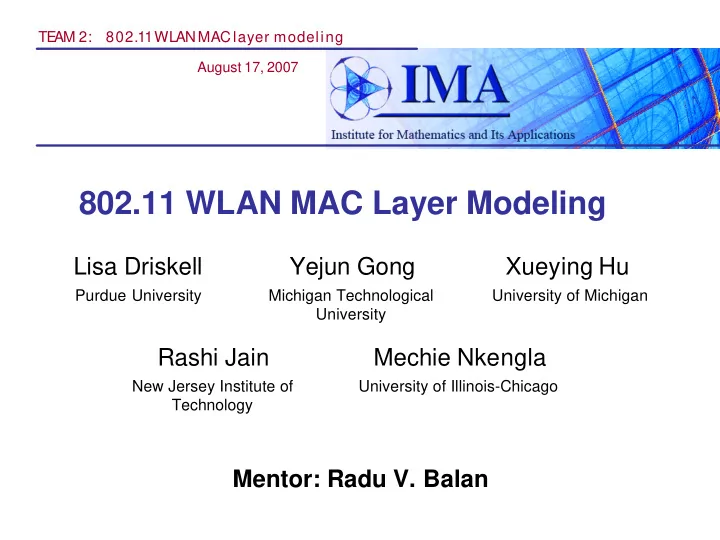

TE AM 2 : 802.11 WLAN MAC layer modeling August 17, 2007 802.11 WLAN MAC Layer Modeling Lisa Driskell Yejun Gong Xueying Hu Purdue University Michigan Technological University of Michigan University Rashi Jain Mechie Nkengla New Jersey Institute of University of Illinois-Chicago Technology Mentor: Radu V. Balan
Outline AM 2 : TE 802.11 WLAN MAC layer modeling � Objective � Overview � ns-2 � Results (.nam) � Results (.tr) � Conclusions � Future Objectives
Objective AM 2 : TE 802.11 WLAN MAC layer modeling Project Objective: Analyze the relationships of the parameters for a modified EO Markov model and validate the model under certain assumptions with (ns2) network simulations.
Overview AM 2 : TE 802.11 WLAN MAC layer modeling System Layout Packets Agent/Null Generated Final Destination Agent/UDP Transmission IFQ MAC MAC
Overview AM 2 : TE 802.11 WLAN MAC layer modeling p
Overview AM 2 : TE 802.11 WLAN MAC layer modeling Previous Analysis of Markov Model p + L 1 Prob (packet dropped due to collision) = Exact # 0 1 2 … b … L retries p 2 (1-p) p b (1-p) p L (1-p) Probability 1-p p(1-p) … … + p L p p − L ( 1 p ) Avg # of retries = − 1 p
Overview AM 2 : TE 802.11 WLAN MAC layer modeling Outline • Analyzed Markov model • Compared analytical results with computed results to verify the analysis. • Use analytical results compared with network simulations to determine whether the system can indeed be modeled with a Markov chain.
Ns-2 AM 2 : TE 802.11 WLAN MAC layer modeling Ns-2 simulator .tr file Input Output Trace File Ns-2 Simulator .tcl file .nam file
Ns-2 AM 2 : TE 802.11 WLAN MAC layer modeling Ns-2 simulator • Closely relates to real world. • A packet-based event-driven simulation. • Can incorporate the wireless mechanism • Allows for mobile stations • Provides animations
Ns-2 AM 2 : TE 802.11 WLAN MAC layer modeling Example of a ns2 simulation
Nam Trace AM 2 : TE 802.11 WLAN MAC layer modeling Nam Trace Format <type> -t <time> -s <source id> -d <destination id> -p <pkt-type> -e <extent> -c <conv> -a <packet attribute> -i <id> -k <trace level> type t s p i k 0~ 0~ cbr, 0~ h, r, d, AGT, +, - MAC simTime NSTA ACK #pkts
Nam Trace : Medium Busy Time AM 2 : TE 802.11 WLAN MAC layer modeling The packet is on the air from t, if at t type= ‘h’ AND k= ‘MAC‘ (Hop) The medium is busy in [ t, t+ pktTransTime] The medium is busy in collision case. TxFrame 2 TxFrame 1 Collision Busy
Nam Trace : Medium Busy Time AM 2 : TE 802.11 WLAN MAC layer modeling Medium Busy Time ? , if NSTA ? < critical number Medium Busy Time ? , if NSTA ? > critical number
AM 2 : TE 802.11 WLAN MAC layer modeling ∑ Numerical: # Retries of this packet = pktSendToT hisNode AvgRetries (node) # pktsSendTo ThisNode with = # Retries(pa cket) # Hop - 1 Theoretical: p = − L AvgRetries (node) * ( 1 p ) 1 - p where p is the collision probabilit y and L is the max # retries. But how to find p?
AM 2 : TE 802.11 WLAN MAC layer modeling pktDropDue Col = p + L 1 + pktDropDue Col pktTransSu c Type=‘h’ AND k=‘AGT’ AND p=‘cbr’ pktSend= pktDropDueCol+ Type=‘d’ AND k=‘IFQ’ AND p=‘cbr’ pktDropDueQueue+ LastHopTime+pktTransTime>sucTime pktDropDueEnd+ Type=‘r’ AND k=‘AGT’ AND p=‘ACK’ pktTransSuc
Results (.nam) AM 2 : TE 802.11 WLAN MAC layer modeling Average number of retries
Results (.nam) AM 2 : TE 802.11 WLAN MAC layer modeling Average number of retries
AM 2 : TE 802.11 WLAN MAC layer modeling Example of a .tr output
Results (.tr) AM 2 : TE 802.11 WLAN MAC layer modeling Average number of retries From simulation From calculation
Results (.tr) AM 2 : TE 802.11 WLAN MAC layer modeling Average number of retries for AP with varying packet period and offset
AM 2 : TE 802.11 WLAN MAC layer modeling Average number of retries with varying packet period and offset 5 Stations
Results (.tr) AM 2 : TE 802.11 WLAN MAC layer modeling Comparison between of the average number of retries from calculation and simulation
Conclusions AM 2 : TE 802.11 WLAN MAC layer modeling Conclusions • Estimated parameter ‘p’ • Determined the saturation value • Established validity of the Markov model • Established importance of assumption of synchronicity
Future Objectives AM 2 : TE 802.11 WLAN MAC layer modeling (Someone Else’s) Future Objectives • Use the .nam and .tr files to extract information about – Average service time – Average wait time • Use the above times to find relationships between parameters • Compare computed results and simulated results for different packet arrival configurations • Compute the throughput/delay • Create a deterministic model
Questions AM 2 : TE 802.11 WLAN MAC layer modeling Questions?
Recommend
More recommend